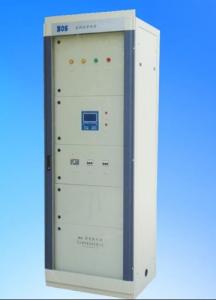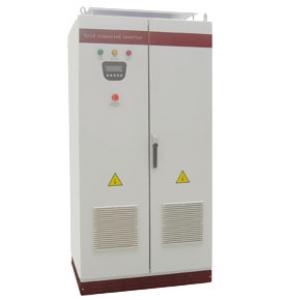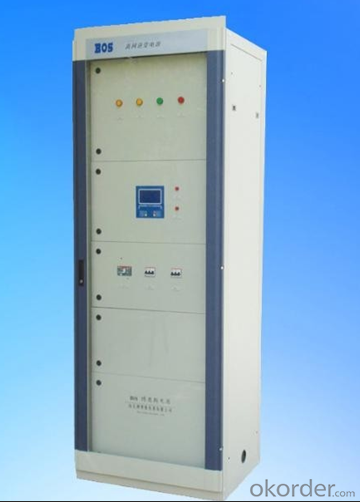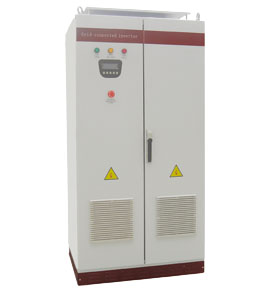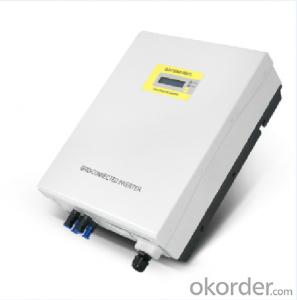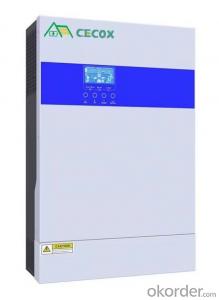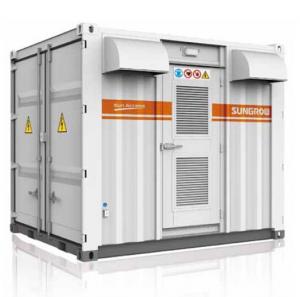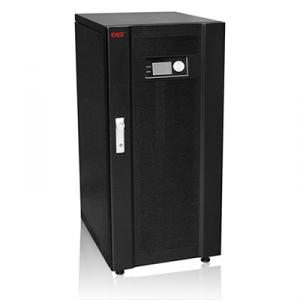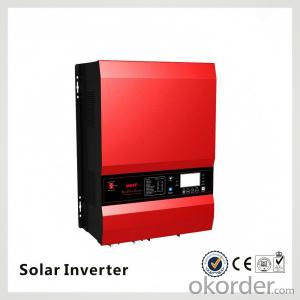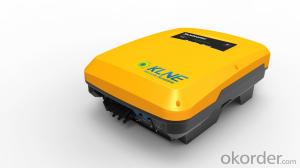48 Volt Solar Inverter PV On-Grid Solar Inverter 12V 220V 5000Watt with MPPT
OKorder Service Pledge
OKorder Financial Service
You Might Also Like
Description:
CNBMSOLAR is a world-leading and Vertical integrated manufacturer of high-performance with Silicon,
Wafer, Cells, Modules, which convert sunlight into electricity for residential, commercial, and utility-scale
power generation.
The capacity of CNBMSOLAR is reach to 1GW, and make sure each year our shipment capacity is more
Than 700-800MWs, at the same time, we have set up the largest solar power station with our partner
in Ukraine.
CNBM is a Quality + Service oriented company with“Excellence at Each Step” approach, composed of
the finest components from TUV and IEC-certified partners around the world, CNBM modules consistently
undergo a variety of trials at the company’s Test & Development Centre, ensuring peak performance
capabilities. The company is committed to develop and provide the world with clean and renewable energy
to ease the energy shortages as well as human kind’s impact on the environment
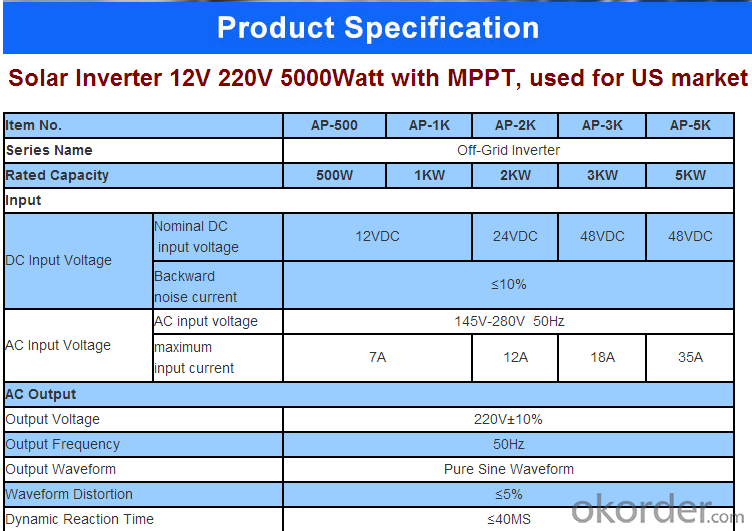
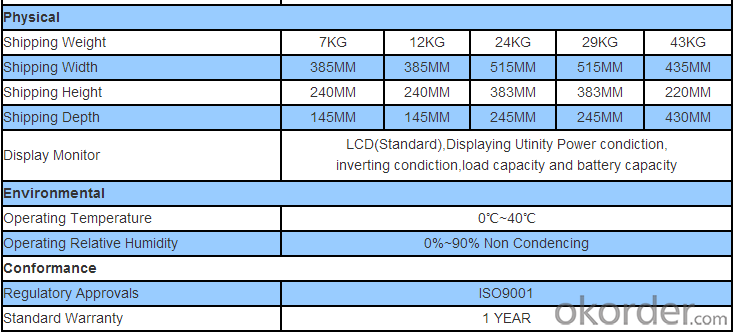
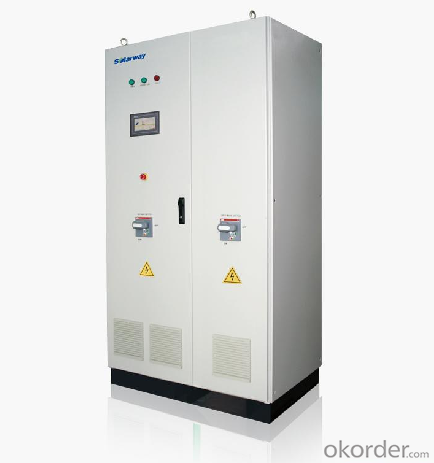
FAQ:What's your products feature?
1. Pure sine wave Output, applicable in various field
2. More stable, safer industrial online system
3. CPU with dual core, Better performance.
4. Availability of wide range of input voltage, AVR available
5. Protection against overload, short circuit, over/lower voltage, over-heat
6. LED+LCD display, evident showing
7. Extended batteries group available for prolonging back-up time
8. Intelligent battery management with over-charge and over-discharge protection
9. Temperature controller adjusting cooling ventilation, reducing noise
10. High efficiency of transferring, diminishing energy loss, increasing stability
- Q: Can a solar inverter be used in areas with high humidity and salt air exposure?
- Yes, a solar inverter can be used in areas with high humidity and salt air exposure. However, it is important to choose a solar inverter that is specifically designed for such conditions, as these factors can potentially impact the performance and lifespan of the inverter. It is advisable to consult with a professional to ensure the selection of a suitable solar inverter for areas with high humidity and salt air exposure.
- Q: Can a solar inverter be used in areas with unstable power grids?
- Yes, a solar inverter can be used in areas with unstable power grids. Solar inverters are designed to convert the direct current (DC) generated by solar panels into alternating current (AC) for use in homes or buildings. In areas with unstable power grids, solar inverters can help stabilize the electricity supply by synchronizing the solar power output with the grid. Additionally, some advanced solar inverters have features like grid support functions and voltage regulation, which can further enhance their performance in areas with unstable power grids.
- Q: What is the typical lifespan of the capacitors in a solar inverter?
- The typical lifespan of capacitors in a solar inverter can vary depending on various factors such as the quality of the components used, the operating conditions, and the amount of stress placed on the capacitors. However, on average, the lifespan of capacitors in a solar inverter can be expected to be around 10 to 15 years. Capacitors are electronic components that store and release electrical energy, and they play a crucial role in the functioning of a solar inverter. They help regulate voltage, smooth out fluctuations in power, and provide stability to the electrical system. The lifespan of capacitors in a solar inverter is influenced by several factors. One of the most significant factors is the quality of the capacitors themselves. Higher quality capacitors tend to have better performance and durability, resulting in a longer lifespan. Cheaper or lower-quality capacitors may degrade or fail more quickly. Another factor that affects the lifespan of capacitors is the operating conditions. Solar inverters are typically installed outdoors, exposed to temperature variations, moisture, and other environmental factors. Extreme temperatures, excessive humidity, or exposure to direct sunlight can potentially accelerate the deterioration of capacitors and reduce their lifespan. Additionally, the stress placed on the capacitors can impact their lifespan. This stress can be caused by factors such as voltage fluctuations, high-frequency switching, or overloading of the inverter. If a solar inverter is operated beyond its design limits or experiences frequent power fluctuations, it can put additional strain on the capacitors, potentially leading to premature failure. Regular maintenance and monitoring of the solar inverter can help identify any potential issues with the capacitors and address them promptly. Some manufacturers may offer warranties or provide information on the expected lifespan of their capacitors, which can give an indication of their durability. In summary, the typical lifespan of capacitors in a solar inverter is around 10 to 15 years, but this can vary depending on factors such as component quality, operating conditions, and stress placed on the capacitors. Regular maintenance and monitoring can help ensure the longevity and optimal performance of the capacitors in a solar inverter system.
- Q: How does a solar inverter handle voltage drop?
- A solar inverter is designed to handle voltage drop by continuously monitoring the voltage level of the solar panels. If the voltage drops below a certain threshold, the inverter adjusts its internal electronics to compensate for the drop and ensure a consistent output voltage. This allows the inverter to maintain optimal performance and efficiency even in situations with voltage fluctuations or drops.
- Q: How does a solar inverter handle ground fault protection?
- A solar inverter handles ground fault protection by continuously monitoring the electrical currents flowing between the solar panels and the grid. If it detects any abnormal current leakage to the ground, it quickly shuts down the system to prevent any potential electrical hazards or damage. This ensures the safety of both the equipment and personnel working with the solar installation.
- Q: Can a solar inverter be easily integrated into an existing electrical system?
- Yes, a solar inverter can be easily integrated into an existing electrical system. It can be connected to the main electrical panel to convert the DC power generated by solar panels into AC power that can be used to power appliances and devices in the building. However, it is important to consult with a professional electrician to ensure proper installation and compatibility with the existing system.
- Q: What maintenance is required for a solar inverter?
- Regular maintenance for a solar inverter typically includes visual inspection for dust or dirt accumulation, checking for loose connections, monitoring the inverter's performance, and ensuring proper ventilation. Additionally, it is recommended to clean the solar panels periodically to maximize the system's efficiency.
- Q: Can a solar inverter be used for off-grid applications?
- Yes, a solar inverter can be used for off-grid applications. Off-grid systems typically rely on solar panels to generate power, and a solar inverter is used to convert the direct current (DC) produced by the panels into alternating current (AC) which can be used to power appliances and devices. The inverter also helps regulate the flow of electricity and ensure compatibility with off-grid power storage systems such as batteries.
- Q: Can a solar inverter be used with a solar-powered vehicle?
- Yes, a solar inverter can be used with a solar-powered vehicle. A solar inverter is used to convert the direct current (DC) produced by solar panels into alternating current (AC) that can be used to power various electrical components of a vehicle. In a solar-powered vehicle, the solar panels generate DC electricity, which is then converted by the solar inverter into AC electricity to charge the vehicle's battery or power its electrical systems.
- Q: Can a solar inverter be used with a wind turbine?
- Certainly! It is indeed possible to utilize a solar inverter alongside a wind turbine. Both wind turbines and solar panels generate direct current (DC) electricity, which necessitates conversion to alternating current (AC) in order to power the majority of household appliances and connect to the electrical grid. The primary function of a solar inverter is to convert DC electricity produced by solar panels into AC electricity. Interestingly, it can also perform the task of converting DC electricity generated by a wind turbine into AC electricity. However, it is worth mentioning that wind turbines typically produce higher voltage and fluctuating currents in comparison to solar panels. As a result, the inverter employed with a wind turbine may require specific design considerations to effectively manage these variations. Additionally, it is common for wind turbines to possess their own specialized inverters that are meticulously optimized to suit their unique electrical characteristics.
Send your message to us
48 Volt Solar Inverter PV On-Grid Solar Inverter 12V 220V 5000Watt with MPPT
OKorder Service Pledge
OKorder Financial Service
Similar products
Hot products
Hot Searches
Related keywords
